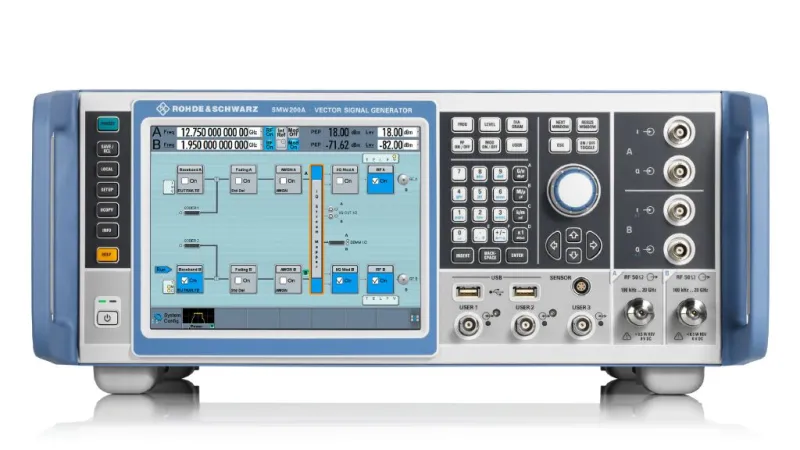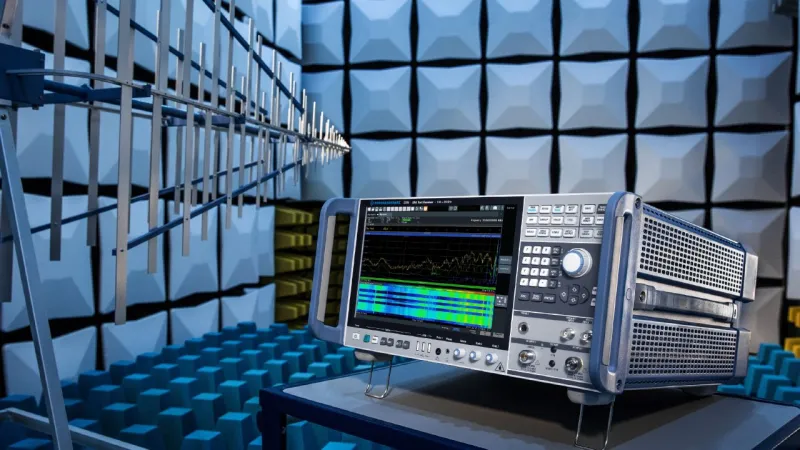
GNSS Simulator Testing
Get Your GNSS Devices to Market Faster
Accelerate your device's time to market with our efficient GNSS test solutions. Ensure global compliance and reliability with our state-of-the-art lab and expert support.
Global Navigation Satellite Systems
The Importance of GNSS Receiver Testing
Global Navigation Satellite Systems (GNSS) are the cornerstone of modern positioning, driving innovations ranging from self-driving cars to precision agriculture and advanced surveying. To ensure your GNSS devices perform flawlessly and conquer global markets, comprehensive testing and certification are essential.
Looking for a complete solution to enter the GNSS market? Our state-of-the-art equipment, including the R&S SMW200A signal generator, creates realistic GNSS environments for repeatable testing. Our team of GNSS specialists will guide you through the entire process and ensure that your GNSS modules comply with the European standard ETSI EN 303 413.
Lab Video
GPS Simulation Testing
In our test laboratory at IB-Lenhart AG, we carry out GNSS tests to evaluate performance and accuracy. Using a Rohde & Schwarz vector signal generator (SMW200A), we generate various GNSS signals with a bandwidth of up to two gigahertz. By simulating GPS signals and inputting coordinates, we can recreate different locations. Additionally, we can generate noise (AWGN) to check reception quality. Benefit from our extensive experience in satellite communication.
ETSI EN 303 413
Standard Testing for the European Union
GNSS modules that are to be used in Europe must pass certain tests in accordance with the ETSI standard EN 303 413. This standard defines requirements for the function and emissions of GNSS modules. There are currently no comparable standards in the USA and Japan.
The EN 303 413 standard comprises two types of tests:
Receiver Blocking Test
This test checks whether the GNSS module is affected by external interference signals.
Receiver Spurious Emissions Test
This test checks that the GNSS module itself does not emit any interfering emissions that could affect other devices.
EN 303 413 Test Setup
Preparation and Test Procedure
- What is the Receiver Blocking Test?
-
The receiver blocking test is carried out in "conducted" mode, whereby the test specimen and the signal generator are connected using an RF cable. The test consists of two parts:
1. GNSS signal only: A GNSS signal is generated and evaluated on the test specimen.
2. GNSS signal and interference signal: A GNSS signal is generated together with an interference signal. It is checked whether the interference signal can influence the "Carrier to Noise" (C/N) values of the GNSS signal on the test object. The C/N values must not change by more than 1 dB.
- Requirements for the Receiver Blocking Test:
-
To carry out the Receiver Blocking Test, the following requirements must be met:
C/N values: The ability to read the C/N values on the device under test (DUT), typically enabled by a software solution.
Conducted connection: A conducted connection (usually SMA) to connect the test specimen to the signal generator using an RF cable.
- Considerations for the DUT Antenna:
-
Check which antenna configuration is available:
Detachable Antenna: If the antenna on the DUT is detachable, no further action is required. The DUT can be connected directly to the RF cable.
Non-detachable Antenna: If the antenna on the DUT is not detachable, an SMA connector must be attached to the GNSS module to connect the DUT to the signal generator using the RF cable.
- What is the Receiver Spurious Emissions Test?
-
The Receiver Spurious Emissions Test is generally carried out in "radiated" mode in fully anechoic chambers. Alternatively, the test can also be carried out with a "conducted" DUT from the blocking test. The aim of the test is to check whether the DUT does not produce spurious emissions above a certain limit when evaluating the received GNSS signal.
- Requirements for the Receiver Spurious Emissions Test:
-
Deactivation of other signals: All other signals/technologies on the DUT (e.g., WLAN, BLE, mobile radio, etc.) must be switched off. The DUT should only evaluate the GNSS signal and not transmit any other signals.
GNSS Constellations
EN 303 413: Signals and Frequency Bands
BDS (Beidou)
| GNSS Signal Designations | RNSS Frequency Band |
|---|---|
| B1l | 1559 MHz to 1610 MHz |
| B1C | 1559 MHz to 1610 MHz |
Galileo
| GNSS Signal Designations | RNSS Frequency Band |
|---|---|
| E1 | 1559 MHz to 1610 MHz |
| E5a | 1164 MHz to 1215 MHz |
| E5b | 1164 MHz to 1215 MHz |
| E6 | 1215 MHz to 1300 MHz |
GLONASS
| GNSS Signal Designations | RNSS Frequency Band |
|---|---|
| G1 | 1559 MHz to 1610 MHz |
| G2 | 1215 MHz to 1300 MHz |
GPS
| GNSS Signal Designations | RNSS Frequency Band |
|---|---|
| L1 C/A | 1559 MHz to 1610 MHz |
| L1C | 1559 MHz to 1610 MHz |
| L2C | 1215 MHz to 1300 MHz |
| L5 | 1164 MHz to 1215 MHz |
SBAS
| GNSS Signal Designations | RNSS Frequency Band |
|---|---|
| L1 | 1559 MHz to 1610 MHz |
| L5 | 1164 MHz to 1215 MHz |
Source: GNSS constellations, GNSS signals and RNSS frequency bands according to ETSI EN 303 413 V1.2.1 (2021-04)
| GNSS Constellation | GNSS Signal Designations | RNSS Frequency Band |
|---|---|---|
| BDS (Beidou) | ||
| B1l | 1559 MHz to 1610 MHz | |
| B1C | 1559 MHz to 1610 MHz | |
| Galileo | ||
| E1 | 1559 MHz to 1610 MHz | |
| E5a | 1164 MHz to 1215 MHz | |
| E5b | 1164 MHz to 1215 MHz | |
| E6 | 1215 MHz to 1300 MHz | |
| GLONASS | ||
| G1 | 1559 MHz to 1610 MHz | |
| G2 | 1215 MHz to 1300 MHz | |
| GPS | ||
| L1 C/A | 1559 MHz to 1610 MHz | |
| L1C | 1559 MHz to 1610 MHz | |
| L2C | 1215 MHz to 1300 MHz | |
| L5 | 1164 MHz to 1215 MHz | |
| SBAS | ||
| L1 | 1559 MHz to 1610 MHz | |
| L5 | 1164 MHz to 1215 MHz |
Source: GNSS constellations, GNSS signals and RNSS frequency bands according to ETSI EN 303 413 V1.2.1 (2021-04)
Let's get in Touch
The experts at IB-Lenhardt AG and IBL-Lab GmbH are always there for you. Just contact us!Advantages
Why IB-Lenhardt AG
We understand that each product is unique and requires customized solutions. That is why we make it a priority to work closely with our customers to meet their individual needs. Your satisfaction is our ultimate goal.
Experience and expertise:
With years of experience in testing and certifying wireless products, we are your reliable partner for GNSS testing.Modern testing facilities:
Our state-of-the-art labs are equipped with the latest technology to ensure accurate and reliable test results.Customer satisfaction:
We place great emphasis on close collaboration with our customers and offer customized solutions for individual requirements.
Take advantage of our worldwide network! With us, your products are always up to date and future-proof.
Frequently Asked Questions
Your Guide to GNSS Technology
- What is GNSS and how does it differ from GPS?
-
GNSS (Global Navigation Satellite System) is the generic term for all satellite-based positioning, navigation and timing (PNT) systems used worldwide. It comprises various systems from different countries, including:
GPS (USA)
GLONASS (Russia)
Galileo (Europe)
BDS (Beidou, China)
SBAS (Space Based Augmentation System)
GPS (Global Positioning System) is a navigation system developed and operated by the US military. In contrast, GNSS refers to all of these systems from different countries. - How does GNSS work?
-
GNSS receivers use time-of-flight measurements from multiple satellites in orbit to calculate their position, velocity and time (PVT) data. By analyzing the time difference between signal transmission and reception, the receiver can perform precise trigonometric calculations together with known satellite locations to determine its exact PVT.
- What are the advantages of GNSS?
-
GNSS offers many advantages, e.g:
Global coverage and high accuracy: GNSS provides centimeter-level positioning accuracy virtually anywhere on earth, enabling sound decision making for your operations regardless of location.
Uninterrupted availability: GNSS provides continuous, real-time position data whenever a clear view of the sky is available, ensuring reliable performance for your applications.
Cross-industry versatility: GNSS technology is the foundation for a variety of applications that enable companies in fields such as surveying, logistics, asset tracking and many others to optimize their operations.
- What are the areas of application for GNSS?
-
GNSS technology extends its reach across diverse industries, fostering:
Enhanced Navigation: From precise fleet management in logistics to real-time asset tracking, GNSS empowers businesses to optimize routes, improve efficiency, and gain real-time visibility into their operations.
Accurate Surveying and Mapping: GNSS underpins high-precision surveying for applications like cadastral mapping, geodetic studies, and construction projects, ensuring data integrity and streamlining workflows.
Synchronized Operations: GNSS provides the critical timing signal for synchronizing power grids and communication networks, guaranteeing seamless performance and system stability.
Advanced Positioning Solutions: Beyond traditional navigation, GNSS facilitates a wide range of positioning applications, such as personnel and wildlife tracking, enabling improved safety, resource management, and data collection.
- What are the challenges of using GNSS?
-
GNSS measurements can be inaccurate or unreliable in some situations, e.g:
In buildings or narrow canyons
Near tall buildings or mountains
In the event of atmospheric interference
In the event of intentional interference (jamming)
When attempting to send GNSS-like signals to the receiver in which false location information is transmitted (spoofing)

IB-Lenhardt AG
Innovative Radio Systems require Innovative Solutions
In our DAkkS-accredited laboratories, we offer comprehensive regulatory testing solutions in accordance with European directives as well as global standards to ensure the reliable operation of your products. Using Rohde & Schwarz test equipment, we test with state-of-the-art equipment and guarantee you reliable service.
We ensure the interoperability of your wireless technologies, such as Bluetooth, Wi-Fi, industrial automation systems, vehicle radar, UWB, Qi technologies and more.
Radio Frequencies
To ensure all necessary radio frequency requirements
Electromagnetic Compatibility
For reliable and trouble-free operation of your device
Electrical Safety
To assure safe operation of your electrical product
Environmental Simulation
To assure reliable operability in harsh environments
Testing & Certification
For Worldwide Market Access
Our comprehensive testing services provide fast and efficient access to global markets while emphasizing cost minimization. We specialize in global wireless product certification and excel at facilitating wireless network integration and ensuring seamless compatibility with IoT devices. Discover a professional partnership that supports your global connectivity goals with precision and efficiency.
Worldwide
International Type Approval
CE (Europe)
Certification for the European market
FCC (USA)
Certification for the United States
ISED (Canada)
Certification for the Canadian market
MIC (Japan)
Certification for the Japanese market

Contact Us
Product Testing for your Needs
We gladly perform electrical product tests tailored to your special demands and support you along the evolution of your product through development-accompanying tests. Send us your inquiry!